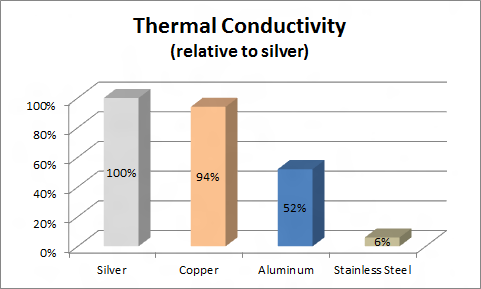Buying pots and pans can be a harrowing experience if you don't know what you should be looking for. The range of technologies and the associated price ranges are vast and confusing. I get a ton of questions on the options available and thought I'd give you a peek at what's in my kitchen.
What's In My Kitchen: Cookware Edition
While it's tempting to look at the selection available and opt for the lowest price on the shelves, many factors need to be taken into consideration. Aside from the price, performance and longevity of cookware, health considerations should not be ignored. Let's take a look at some of the options you'll find when shopping for cookware.
Nonstick cookware is created by coating a pan with a substance such as polytetrafluoroethylene (PTFE) to minimize food sticking to the pan. It has an obvious benefit over stainless steel and you'll notice it the first time you go to cook eggs. However, over the past number of years the cons have begun to far outweigh the pros. The chemicals used to coat the pans inevitably break down with time and are ingested. In addition, caring for nonstick pans can be quite the chore. You are limited to using certain utensils and specific cleaning tools. Even with the best of care a nonstick pan is only going to last you a few years at best.
Copper is a great choice if you can handle the price. Quality cookware is all about transferring the heat from your cooking source to the food in your pot in an efficient and even matter. Copper is an excellent choice as a great conductor of heat. This means it gets to temperature efficiently and maintains temperature evenly. The first drawback with copper is certainly the price. Copper cookware can often cost significantly more than other materials. For this reason it is often not a great choice for the average home cook. In addition, copper cookware generally has a tin lining to stop the copper from reacting with acidic foods (thus changing the flavour of whatever you may be cooking). In addition to the upfront cost, copper pots also need to be re-tinned every so often.
Cast iron cookware is slow to heat but does retain a very even temperature once heated. While excellent for cooking high heat foods, iron can also react with acidic foods, is quick to rust, and is fairly heavy.
Aluminum cookware is a fairly good conductor of heat (as seen above) and is relatively inexpensive. However, it has been found to be a health concern when used for cooking. Over time as the cookware take wear and tear the metal breaks down and can leach into your foods. There is a laundry list of health concerns and dangers of using aluminum cookware. So while price and performance make it a tempting option, it is definitely not worth the health risks associated. Aluminum can also react with the acidity of your food changing the flavour of whatever you are cooking. It is also not dishwasher safe.
Stainless steel is made up of a combination of chromium and nickel. It does not react with acidic foods, nor does it corrode. It is also scratch and dent resistant. Unfortunately, stainless steel is a fairly poor conductor of heat which dos not make it very good as a lone material for cooking. From a health perspective, chromium is a toxic metal that can be unsafe if ingested in large amounts. However, it is also a metal that is good for us in small amounts. For your reference, here is the Health Canada
report on safe cookware.
Many companies use combinations of different metals to try and get the best of all worlds. For example, many offer stainless steel cookware with copper bottoms. Thus using the great performance of copper to transfer heat to the pot, but using stainless steel for the bulk of the cookware to keep pricing down.
I use a tri-ply cookware set by Calphalon. It's built using three individual layers of metal. The interior and exterior layers are made from stainless steel. The middle layer is made from aluminum for efficient heat conduction. As mentioned, stainless steel is not an efficient conductor of heat; aluminum, by contrast, is highly conductive. The aluminum inside is key in making the stainless steel cookware perform so well. Again, maximizing performance within a reasonable price range without compromising health.
Calphalon has generously offered to provide one of my readers with a Tri-ply Stainless Steel Covered Chef's Pot (retail $115).
To enter just tell me what yummy dish you'd like to make in your new pot in the comments below.
Yummy Rules and Regs: You must be a Yummy Mummy Club member to win. Click to sign up! It's free and filled with perks. One comment per member. Entries accepted until August 22, 2012. Winners will be picked using www.random.org.


